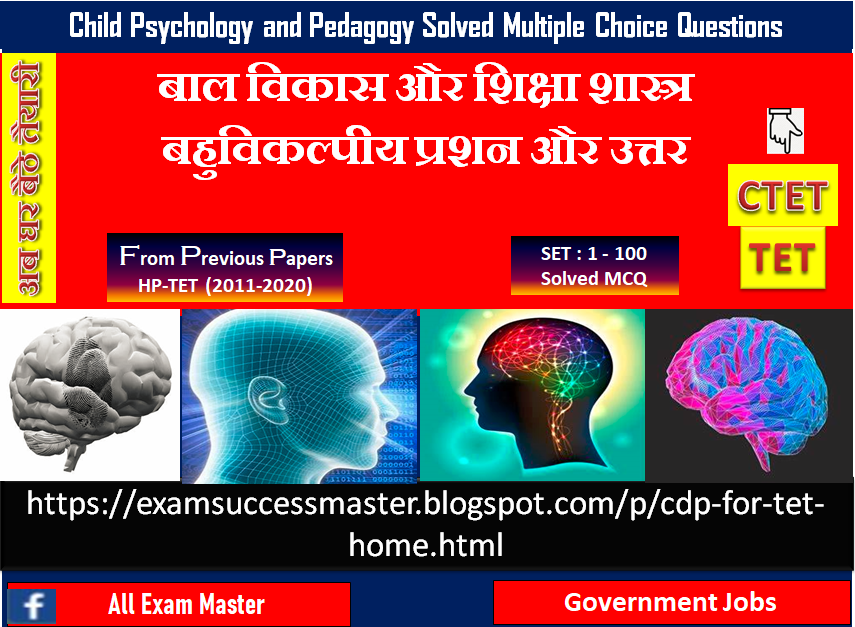Child Development and Pedagogy for TET Exam
बाल विकास और शिक्षा शास्त्र बहुविकल्पीय प्रश्न
Welcome to our exclusive collections of previously asked Child development and Pedagogy (CDP) multiple choice questions (MCQ) asked in previous HP-TET Exams. Child development is the very important section for TET exams. In this section 30 question will be asked and candidates can score above 25+ marks easily. In this section mainly questions asked from inclusive Education, child development, and learning pedagogy click given below link in bottom of each page for complete study notes of child development..
इस पोस्ट में हम बाल विकास और शिक्षा शास्त्र से सम्बंधित कई महत्वपूर्ण बहुविकल्पीय प्रश्न प्रस्तुत कर रहे है , जो कई प्रतियोगी परीक्षाओ में पूछे जाते है. जैसे TET, CTET, JEE, AIPMT, PMT, Police exams ,army exams, CDSE , SBI Clerk , SBIPO, PO, RRB , IBPS PO , PSc, State PSC, Patwari, Samvida, Teacher recruitment test, UPSC, SSC, CGL, SI, CTET, TET, CDS, MAT, SSC 10+2, CLAT, NIFT, SBI, IBPS Clerk, Vyapam, आदि.
Child Development and Pedagogy for TET Exam | SET – 23
Question : 1-10
Question : 1
Orthopedically impaired chidren are likely to have
[A]. Dyscalculia[B]. Dyslexia is associated with
[C]. Dysqraphia
[D]. Dysthemia
Asked in:HP TET Non-Medical-Nov-2019
Question : 2
Each cell possesses 46 ………..that are responsible for all genetic information passes from parents to children.
[A]. Genes[B]. Chromosomes
[C]. Zygotes
[D]. Gametes
Asked in:Himachal Pradesh TET JBT/D.El.Ed-2013
Question : 3
Intelligence is the ability
[A]. To learn[B]. To adjust oneself to new situations
[C]. To think in term of ideas
[D]. All of these
Asked in:Himachal Pradesh TET Medical-2017
Question : 4
The National Policy on Education, 1986 envisages education as
[A]. Investment[B]. Return
[C]. National Programme
[D]. Social programme
Asked in:Himachal Pradesh TET Non-Medical-2014
Question : 5
A child has been admitted to your school who belongs to a backward family/background from the cultural viewpoint. You will
[A]. Keep him in a class in which , there are many more students of backward of the child[B]. Send a teacher to know more about the backward cultural background of the child
[C]. Keep him in normal class but will make special arrangements fot teaching him, keeping his special needs in view.
[D]. Advice him to take up vocational education
Asked in:Himachal Pradesh TET JBT/D.El.Ed-2013
Question : 6
The lowest and highest score of a distribution signifies
[A]. Length[B]. Range
[C]. Width
[D]. Distance
Asked in:Himachal Pradesh TET Non-Medical-2014
Question : 7
Who propogated two factor theory of peronality?
[A]. Binet ,Theman and Stern[B]. Spearman
[C]. Thorndike
[D]. Thurston
Asked in:Himachal Pradesh TET ARTS 2017
Question : 8
Group factor theory is related to
[A]. Binet[B]. Hull
[C]. Skinner
[D]. Thruston
Asked in:Himachal Pradesh TET Non-Medical-2014
Question : 9
एक बच्चे की ज्ञानात्मक विकास की कौन सी अवस्था है जिसमें वह कार्य समस्या को तर्कबद्ध करने मे समर्थ हो और बहुवर्गीकरण कर सकता हो ?
[A]. पुर्व-परिचालन अवस्था[B]. औपचारिक परिचालन अवस्था
[C]. निश्चत परिचालन अवस्था
[D]. संवेदी-मोटर अवस्था
Asked in:Himachal Pradesh TET ARTS 2012
Question : 10
During the formal operations stage, children begin to
[A]. Accurately use concepts of time, space and situations[B]. Think primarily about concrete objects or situations
[C]. Develop the concept of object permanency
[D]. Think in terms of abstract principles and hypothetical possibilities
Asked in:Himachal Pradesh TET JBT/D.El.Ed-2013
To Read Next Set
Click on below links
- Child Development and Pedagogy for TET Exam
बाल विकास और शिक्षा शास्त्र बहुविकल्पीय प्रश्न | SET – 17 - Child Development and Pedagogy for TET Exam
बाल विकास और शिक्षा शास्त्र बहुविकल्पीय प्रश्न | SET – 18 - Child Development and Pedagogy for TET Exam
बाल विकास और शिक्षा शास्त्र बहुविकल्पीय प्रश्न | SET – 19 - Child Development and Pedagogy for TET Exam
बाल विकास और शिक्षा शास्त्र बहुविकल्पीय प्रश्न | SET – 20 - Child Development and Pedagogy for TET Exam
बाल विकास और शिक्षा शास्त्र बहुविकल्पीय प्रश्न | SET – 21 - Child Development and Pedagogy for TET Exam
बाल विकास और शिक्षा शास्त्र बहुविकल्पीय प्रश्न | SET – 22 - Child Development and Pedagogy for TET Exam
बाल विकास और शिक्षा शास्त्र बहुविकल्पीय प्रश्न | SET – 23 - Child Development and Pedagogy for TET Exam
बाल विकास और शिक्षा शास्त्र बहुविकल्पीय प्रश्न | SET – 24 - Child Development and Pedagogy for TET Exam
बाल विकास और शिक्षा शास्त्र बहुविकल्पीय प्रश्न | SET – 25 - Child Development and Pedagogy for TET Exam
बाल विकास और शिक्षा शास्त्र बहुविकल्पीय प्रश्न | SET – 26
Please Read These Useful Post Also
कृपया इन्हें भी पढ़ें
MCQs Practice Sets for Sure Success in all competitive exams
- HP GK MCQs
- HP GK in Hindi
- Indian GK
- Indian History
- Geography
- Indian Politics
- Insian Economy
- Constitution of India
- Indian Railaway
- Computer Awareness
- Environmental studies(EVS)
- CTET
- Sports GK
- World GK
- HP-TGT Commission
- HP TET
- Current Affairs
- Psychology
- Psychology(Hindi)
- Physics Solved
- Biology Solved
- English Grammar
- Banking Exam MCQs
- HP-TGT-NM-Commission
- HP-TGT-Medical-Commission
- HP-TGT-Arts-Commission
- HP-TGT-LT-Commission


No comments:
Post a Comment